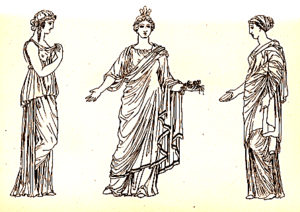Clothing in Ancient Greece facts for kids
Clothing in Ancient Greece was quite simple. People usually wore big, rectangular pieces of cloth. This cloth was rarely sewn, or not sewn at all! Instead, they wrapped the cloth around their body. They used belts, fibulae (which are like large safety pins), or other fastenings to hold it in place. The main materials for clothing were linen or wool.
Contents
Types of Greek Clothing
Ancient Greeks wore different types of clothing. Each style had its own way of being wrapped and fastened.
The Peplos
The peplos was a dress worn by women in ancient Greece. It was a large square piece of cloth. The cloth was folded over at the top to create a double layer. This top part was called the apoptygma.
The peplos was then wrapped around the body. It was fastened over each shoulder. There were two main types. The ionic or laconic peplos was open on one side. The doric peplos was sewn shut like a tube. Women wore the peplos so the opening was on their right side.
Often, a belt was worn over the peplos. This belt could be placed either over or under the apoptygma. The peplos was most popular in Greece before the 5th century BC.
The Chiton
The chiton was another common garment. Both women and men wore it. It was also made from a large piece of cloth.
The doric chiton was very basic. It was usually made of wool. The cloth was folded and wrapped around the body. It was fastened at the shoulders with brooches. The fabric would then fall into soft folds. A belt, often called a girdle, was worn around the waist. This held the chiton in place.
The ionic chiton was different. It was sewn like a tube. This style often used linen. The material was folded and sewn, leaving holes for the head and arms. An Ionic chiton also used a belt. This belt helped keep the clothing in position. It also made the fabric fall nicely from the waist down.
The Himation
The himation was a large piece of cloth. It was used as a cloak. Both men and women wore himatia. People usually draped the himation from their back. It went over the left shoulder. The other part went under the right arm. Then it wrapped around the front of the body.
The himation was quite long. It could reach down to the knees or even longer. It was often made from lighter cloth. This made it a good cloak for warm weather.
The Chlamys
The chlamys was a shorter cloak. It was a piece of cloth. It was draped over the left shoulder. Then it was fastened over the right shoulder. The chlamys was mostly worn by men or soldiers.
What Women Wore
Women in Ancient Greece wore long dresses and cloaks. Their main clothes were the peplos and the chiton. They also wore the himation as an outer garment.
Beauty and Make-up
Cosmetics and make-up were used in Ancient Greece. Women used White lead to make their skin look whiter. White skin was seen as a sign of beauty. They also used Juice from alkanet roots. This gave their cheeks a rosy colour, like rouge.
Eye shadow, probably made from ashes, was popular. Lipstick was also used. Perfumes were very important too.
What Men Wore
Men's clothing was even simpler than women's. The most important item was a shorter version of the chiton. This was also belted at the waist. Men often left one shoulder bare. This was common if they were exercising or doing hard work.
The himation was also worn by men. It was especially useful for long journeys. Sometimes, men wore a long robe. This robe would leave the right shoulder uncovered. Men usually wore no clothes when training for military reasons.
Shoes in Ancient Greece
At home, people often went without shoes. But when they were in the streets or travelling, they wore leather sandals. These sandals were very simple. They were usually made to measure.
A person would go to the cobbler's shop. They would place their foot on a piece of leather. The sole was then cut out around the foot. Leather thongs attached the sole to the foot. These thongs were tied across the instep and around the ankle.




